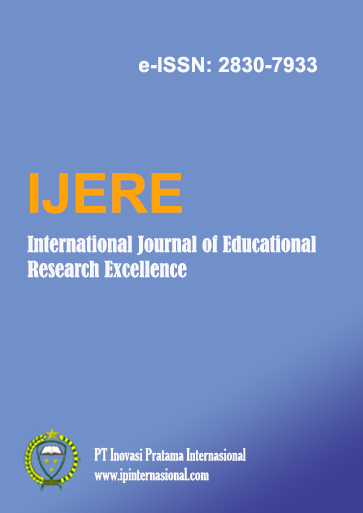Mathematics Learning Revolution: Implementation of Geogebra in Spldv Material
Main Article Content
Abstract
This article discusses the use of GeoGebra as a tool in learning Systems of Linear Equations in Two Variables (SPLDV). GeoGebra, created by Markus Hohenwarter in 2001, has grown to become one of the most popular educational tools worldwide, allowing students and teachers to explore mathematical concepts visually and interactively. With features such as graph generation, mathematical object manipulation, and intersection analysis, GeoGebra facilitates a deeper understanding of SPLDV. The purpose of this article is to explain how using GeoGebra can simplify the learning process for Systems of Linear Equations in Two Variables (SPLDV). The research methodology used includes qualitative and quantitative approaches, by measuring student understanding before and after using GeoGebra. The research results show that GeoGebra not only improves understanding of mathematical concepts, but also develops students' problem solving and critical thinking skills. Thus, GeoGebra contributes significantly to improving the quality of mathematics teaching and learning.
Downloads
Article Details

This work is licensed under a Creative Commons Attribution 4.0 International License.
References
Amalia Yunia Rahmawati. (2020). CompletedNo Title No Title No Title. July, 1–23.
Andini, R., & Retno Winarti, E. (2022). Students' Critical Thinking Ability in the Problem-Based Learning Model Assisted with Teaching Materials with a STEM Approach. PRISM. Proceedings of the National Mathematics Seminar, 5.
Cao, Y., AlKubaisy, Z. M., Stojanović, J., & ... (2022). Appraisal of information and communications technologies on the teaching process by neuro fuzzy logic. Computer …. https://doi.org/10.1002/cae.22486
Daroini, A. F., Wiryokusumo, I., & Leksono, I. P. (2022). HUMAN INTERACTION WITH COMPUTERS: MATHEMATICS MODULE WITH GEOGEBRA APPLICATION. JIPI (Scientific Journal of Informatics Research and Learning), 7(2). https://doi.org/10.29100/jipi.v7i2.2696
Hamzah, N. A. H., & Hidayat, R. (2022). The Role of Geogebra Software in Mathematics Education: A Systematic Literature Review: The Role of Geogebra Software in Mathematics Education: Highlights…. Journal of Science And Mathematics Education.... http://ojs.upsi.edu.my/index.php/JPSMM/article/view/6495
Hanifah, H., & Antasari, M. (2022). Obstacles and Tips for Successful Implementation of Geometry LKPD Based on the Apos Model Assisted by Geogebra. Dharma Raflesia: Scientific Journal of Development and Application of Science and Technology, 20(1). https://doi.org/10.33369/dr.v20i1.20014
Hasibuan, Y. R., Khairani, N., & Surya, E. (2023). The Influence of Initial Mathematical Ability and the Geogebra-assisted 5e Learning Cycle Model to Improve Students' Mathematical Problem Solving Abilities and Students' Mathematical Learning Independence. Scholar's Journal: Journal of Mathematics Education, 7(1). https://doi.org/10.31004/cendekia.v7i1.2168
Hidayat, T. (2021). USE OF THE GEOGEBRA APPLICATION AS A MEDIA FOR VOCATIONAL SCHOOL MATHEMATICS LEARNING. Educational Innovation, 8(1). https://doi.org/10.31869/ip.v8i1.2573
Juandi, D. (2021). The Effectiveness of Dynamic Geometry Software Applications in Learning Mathematics: A Meta-Analysis Study. International Journal of Interactive Mobile Technologies, 15(2), 18–37. https://doi.org/10.3991/ijim.v15i02.18853
Maulidiya, D., Utari, T., Irsal, N. A., & Aziza, M. (2023). Investigation of the use of geogebra for mathematics learning in Indonesia: A bibliometric analysis. Delta-Pi: Journal of Mathematics and Mathematics Education, 12(1). https://doi.org/10.33387/dpi.v12i1.6557
Muhartini, Mansur, A., & Bakar, A. (2023). CONTEXTUAL LEARNING AND PROBLEM BASED LEARNING. Badge: Journal of Educational Science Innovation, 1(1).
Muzdalipah, I., Rustina, R., Patmawati, H., & Yulianto, E. (2023). DEVELOPMENT OF TEACHING MATERIALS USING GEOGEBRA ON TRIANGLES AND QUARTARIANS. Theorems: Mathematical Theory and Research, 8(1). https://doi.org/10.25157/teorema.v8i1.10090
Nuritha, C., & Tsurayya, A. (2021). Development of Geogebra Assisted Learning Videos to Increase Student Learning Independence. Scholar's Journal: Journal of Mathematics Education, 5(1). https://doi.org/10.31004/cendekia.v5i1.430
Putri, A. D., Hasnita, S., Vilardi, M., & Setiawan, W. (2019). Analysis of the Influence of MA Students' Learning Interest Using the Geogebra Application on SPLDV Material. Edumatica: Journal of Mathematics Education, 9(1). https://doi.org/10.22437/edumatica.v9i1.6348
Rangkuti, R. K., Suprihatiningsih, S., Rahayu, S., & Razy, M. A. (2023). DEVELOPMENT OF MATHEMATICS LEARNING MEDIA ASSISTED WITH GEOGEBRA TO IMPROVE STUDENTS' ABILITY TO UNDERSTAND MATHEMATICAL CONCEPTS. Riemann: Research of Mathematics and Mathematics Education, 5(1). https://doi.org/10.38114/riemann.v5i1.294
Sopanda, L., Sari, S. K. N., & Mardiana, M. (2022). Integration of Geogebra and Problem-Based Learning in Improving Understanding of SPLDV Material Concepts. Winner of Wawasan Dan Aksara Journal, 2(1). https://doi.org/10.58740/juwara.v2i1.36
Yaniawati, P. (2020). Integration of e-learning for mathematics on resource-based learning: Increasing mathematical creative thinking and self-confidence. International Journal of Emerging Technologies in Learning, 15(6), 60–78. https://doi.org/10.3991/ijet.v15i06.11915
Yessi, Y. K., Kartika, Y., & Yusnaini, Y. (2021). EFFORTS TO IMPROVE STUDENT LEARNING OUTCOMES THROUGH THE DISCOVERY LEARNING MODEL WITH THE AID OF GEOGEBRA SOFTWARE ON ALGEBRA FUNCTION LIMITS MATERIAL IN CLASS XI MAN 2 BIREUEN. JOURNAL GAMMA-PI, 3(1). https://doi.org/10.33059/jgp.v3i1.3850

